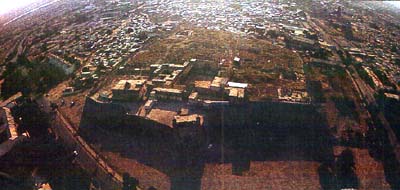| |
The snootiest neighbourhood of a Central Asian city was
traditionally its north-western  corner.
In Bukhara, this is where you find the rulers' 2000-year-old fortress,
the Ark. The Registan outside its main gate used to contain a mosque, the
royal arsenal and a huge open-air bazaar, but is empty nowadays. The rest
of the quarter, inhabited by aristocrats and artisans until the death of
class society in the 1920s, was known as the Shahristan, or city proper. corner.
In Bukhara, this is where you find the rulers' 2000-year-old fortress,
the Ark. The Registan outside its main gate used to contain a mosque, the
royal arsenal and a huge open-air bazaar, but is empty nowadays. The rest
of the quarter, inhabited by aristocrats and artisans until the death of
class society in the 1920s, was known as the Shahristan, or city proper.
Bukhara's first citadel was built before the dawn of recorded
time by one Siyavush ibn-Keikavus, who ran away from home and won the hand
of the daughter of Afrasiab (of ancient Samarkand fame), together with
all his father-in-law's property. Siyavush intended the citadel as a memorial
to himself and it became one when Afrasiab had him killed for alleged slander.
He was buried under the east gates, which the city's fire-worshippers revered
ever after and to which, once a year, a sacrificial cockerel was brought.
Whoever really built the first citadel, the Arabs
destroyed it in the 8th century. The Samanids and Karakhanids built on
the rubble in the 10th and 11th centuries, and the Mongols turned their
work into more rubble in the 13th. By the 16th century the Sheibanids were
building on an artificial hill 800 m round and some 20 m above the Registan.
The Ark became a city within a city, housing in the 18th century the police
department, prison, mint, treasury, armoury, its own mosques and a population
of 3000, as well as the royal apartments, reception rooms and stables.
Most of the buildings had wooden frames, and in 1920 they were destroyed
by a fire which the last emir, Alim Khan, may have started himself as he
fled the Bolsheviks.
[back]
[Write to us]
|
|

